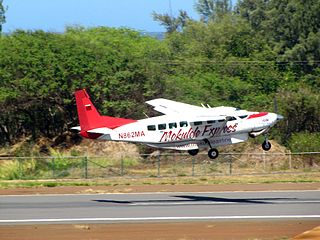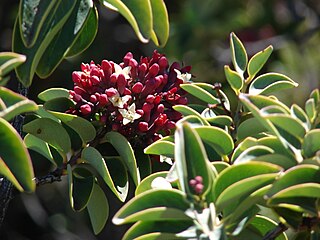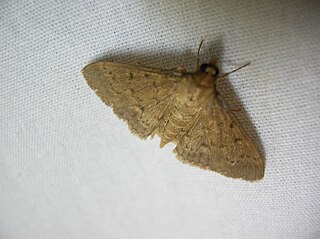
Molokai is the fifth most populated of the eight major islands that make up the Hawaiian Islands archipelago in the middle of the Pacific Ocean. It is 38 by 10 miles at its greatest length and width with a usable land area of 260 sq mi (673.40 km2), making it the fifth-largest in size of the main Hawaiian Islands and the 27th largest island in the United States. It lies southeast of Oʻahu across the 25 mi (40 km) wide Kaʻiwi Channel and north of Lānaʻi, separated from it by the Kalohi Channel.
The University of Hawaiʻi Maui College (UHMC) is a public college in Kahului, Hawaiʻi on the island of Maui. It is one of ten branches of the University of Hawaiʻi system and is accredited by the Western Association of Schools and Colleges.

This is a list of properties and historic districts in Hawaii listed on the National Register of Historic Places. More than 340 listings appear on all but one of Hawaii's main islands and the Northwestern Islands, and in all of its five counties. Included are houses, schools, archeological sites, ships, shipwrecks and various other types of listings. These properties and districts are listed by island, beginning at the northwestern end of the chain.

Mokulele Airlines is an American commuter airline operating in Hawaii. The airline operates scheduled inter-island and charter flights among all Hawaiian islands with airports. Mokulele Airlines was the first FAA Part 135 Scheduled Airline to have approved iPad "Flight bags" for its pilots. In 2019, it was acquired by Southern Airways Express, but it continues to operate as its own brand within the larger airline. In June 2020, Makanai Kai Air was also acquired by Southern, and its aircraft now fly in Mokulele livery.

Santalum haleakalae, known as Haleakala sandalwood or ʻIliahi in Hawaiian, is a species of flowering tree in the sandalwood family, that is endemic to the islands of Maui, Lanai, and Molokai in the Hawaiian Islands, part of the United States. It grows in subalpine shrublands at elevations of 1,900 to 2,700 m, especially on the slopes of Haleakalā.

The East Molokai Volcano, sometimes also known as Wailau for the Wailau valley on its north side, is an extinct shield volcano comprising the eastern two-thirds of the island of Molokaʻi in the U.S. state of Hawaii.
Eudonia ombrodes is a moth of the family Crambidae. It is endemic to the Hawaiian islands of Oahu, Molokai, Maui, Lanai and Hawaii.

Omiodes localis is a moth of the family Crambidae. It is endemic to the Hawaiian islands of Kauai, Oahu, Molokai, Maui, Lanai and Hawaii.
Udea liopis is a moth of the family Crambidae. It is endemic to the Hawaiian islands of Maui, Hawaii, Kauai, Oahu, Molokai and Lanai.
Udea despecta, the Hawaiian sweetpotato leafroller, is a moth of the family Crambidae. It is endemic to the Hawaiian islands of Kauai, Oahu, Molokai, Maui, Lanai and Hawaii.
Orthomecyna phaeophanes is a moth of the family Crambidae. It is endemic to the Hawaiian islands of Kauai, Oahu, Molokai and Maui.

Mestolobes minuscula is a moth of the family Crambidae described by Arthur Gardiner Butler in 1881. It is endemic to the Hawaiian islands of Kauai, Oahu, Molokai, Maui, Lanai and Hawaii.
Eccoptocera foetorivorans is a moth of the family Tortricidae. It was first described by Arthur Gardiner Butler in 1881. It is endemic to the Hawaiian islands of Kauai, Oahu, Molokai, Maui, Lanai and Hawaii.
Bactra straminea is a moth of the family Tortricidae. It was first described by Arthur Gardiner Butler in 1881. It is only known from the Hawaiian islands of Kauai, Oahu, Molokai, Maui, Lanai and Hawaii, but might be an introduced species, although it has not been recorded from any other location.

Apteribis is an extinct genus of flightless birds in the ibis subfamily that was endemic to the Hawaiian Islands in the Pacific Ocean.
Mike Spalding is a marathon swimmer, and one of only two people to have swum all nine channels of the main Hawaiian Islands. He lives on Maui. On March 16, 2009 Spalding became one of the few humans to be attacked by the deep water cookiecutter shark. He was bitten by one of the sharks while swimming between the islands of Hawai'i and Maui in what is referred to as the Alenuihaha Channel. The attack occurred at 8:15 pm 10 miles off Upolu point. The cookiecutter shark was attracted to squid that were in turn drawn to the light on the escort boat. Just before the attack the swimmer felt squid bumping into him while swimming. The cookiecutter shark first attached itself to the upper torso but did not bite as it was scared away by the swimming motion. On exiting the water into the escort kayak the second bite took a round cookiecutter chunk of flesh out of the lower left calf. Spalding completed the crossing a year and a half later without incident except for the appearance of an oceanic whitetip shark in the same vicinity of the cookiecutter shark incident.

The 2016 United States House of Representatives elections in Hawaii occurred on November 8, 2016. The electorate chose two candidates to act in the U.S. House, one from each of the state's two districts. Hawaii is one of 14 states that employ an open primary system, meaning voters do not have to state a party affiliation in the election. The primaries were held on August 13.
An earthquake struck near the Hawaiian island of Lanai on February 19, at 10:11 pm HST with an estimated magnitude of 7.5 on the moment magnitude scale (Mw ). It remains one of the largest seismic event to hit the Hawaiian Islands since the 1868 Ka‘ū earthquake, with its effects being felt throughout the entire archipelago. It caused severe damage on the islands of Lanai, Molokai and Maui. A tsunami may have been generated however there are speculations if it had actually happened. Despite the size of the quake and the extent of damage, there were no deaths.








